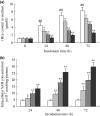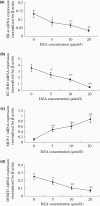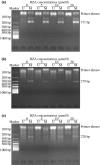Relationship of impairment induced by intracellular S-adenosylhomocysteine accumulation with DNA methylation in human umbilical vein endothelial cells treated with 3-deazaadenosine
- PMID: 19958400
- PMCID: PMC2803255
- DOI: 10.1111/j.1365-2613.2009.00687.x
Relationship of impairment induced by intracellular S-adenosylhomocysteine accumulation with DNA methylation in human umbilical vein endothelial cells treated with 3-deazaadenosine
Abstract
The aim of this study was to estimate the relationship of endothelial dysfunction induced by intracellular S-adenosylhomocysteine (SAH) accumulation and DNA methylation in human umbilical vein endothelial cells (HUVEC). The isolated HUVEC were incubated with 3-deazaadenosine (DZA) to induce experimental intracellular SAH accumulation. The impairment of HUVEC function was assessed by changes in morphology and proliferative ability. The expression of DNA methyltransferase-1 (DNMT1) and the atherosclerosis related genes [oestrogen receptor-alpha (ER-alpha), extracellular superoxide dismutase (EC-SOD) and monocyte chemoattractant protein-1 (MCP-1)] were analysed using quantitative real-time PCR. Global DNA methylated status was measured using the cytosine extension assay. The methylated patterns of ER-alpha, EC-SOD and MCP-1 genes were determined with methylation-specific PCR. We found that DZA administration increased intracellular SAH levels progressively and simultaneously decreased Hcy content in medium. Moreover, the supplementation induced HUVEC apoptosis, inhibited proliferation ability and DNMT1 mRNA expression (P < 0.05) and furthermore reduced global DNA methylation status (P < 0.05). Correlation analysis showed the presence of a negative correlation between intracellular SAH concentration, proliferative ability, and expression of ER-alpha, EC-SOD, and DNMT1 (r = -0.89, -0.86, -0.92 and -0.88 respectively, P < 0.001); and a positive correlation with MCP-1 expression and DNA [(3)H]-dCTP incorporation (r = 0.89 and 0.93 respectively, P < 0.001). Our results showed that endothelial dysfunction induced by intracellular SAH accumulation is mediated by regulating the expression of atherosclerosis related genes in HUVEC, which is not related with gene promoter methylated patterns, but may be associated with altered global DNA hypomethylated status. These findings suggest that SAH can act as the potential molecular biological marker in the promotion of atherogenesis.
Figures






Similar articles
-
S-Adenosylhomocysteine induces apoptosis and phosphatidylserine exposure in endothelial cells independent of homocysteine.Atherosclerosis. 2012 Mar;221(1):48-54. doi: 10.1016/j.atherosclerosis.2011.11.032. Epub 2011 Nov 28. Atherosclerosis. 2012. PMID: 22204864
-
Intracellular S-adenosylhomocysteine increased levels are associated with DNA hypomethylation in HUVEC.J Mol Med (Berl). 2005 Oct;83(10):831-6. doi: 10.1007/s00109-005-0679-8. Epub 2005 Jun 23. J Mol Med (Berl). 2005. PMID: 15976919
-
Liuwei Dihuang prevents postmenopausal atherosclerosis and endothelial cell apoptosis via inhibiting DNMT1-medicated ERα methylation.J Ethnopharmacol. 2020 Apr 24;252:112531. doi: 10.1016/j.jep.2019.112531. Epub 2020 Jan 8. J Ethnopharmacol. 2020. PMID: 31926314
-
Folic Acid Supplementation Delays Atherosclerotic Lesion Development by Modulating MCP1 and VEGF DNA Methylation Levels In Vivo and In Vitro.Int J Mol Sci. 2017 May 5;18(5):990. doi: 10.3390/ijms18050990. Int J Mol Sci. 2017. PMID: 28475147 Free PMC article.
-
The Contribution of Homocysteine Metabolism Disruption to Endothelial Dysfunction: State-of-the-Art.Int J Mol Sci. 2019 Feb 17;20(4):867. doi: 10.3390/ijms20040867. Int J Mol Sci. 2019. PMID: 30781581 Free PMC article. Review.
Cited by
-
Methylation status of CpG sites in the MCP-1 promoter is correlated to serum MCP-1 in Type 2 diabetes.J Endocrinol Invest. 2012 Jun;35(6):585-9. doi: 10.3275/7981. Epub 2011 Oct 3. J Endocrinol Invest. 2012. PMID: 21975431
-
Genome-wide methylation and gene expression changes in newborn rats following maternal protein restriction and reversal by folic acid.PLoS One. 2013 Dec 31;8(12):e82989. doi: 10.1371/journal.pone.0082989. eCollection 2013. PLoS One. 2013. PMID: 24391732 Free PMC article.
-
Anti-inflammatory effects of a Chinese herbal medicine in atherosclerosis via estrogen receptor β mediating nitric oxide production and NF-κB suppression in endothelial cells.Cell Death Dis. 2013 Mar 21;4(3):e551. doi: 10.1038/cddis.2013.66. Cell Death Dis. 2013. PMID: 23519120 Free PMC article.
-
Hyperhomocysteinaemia and vascular injury: advances in mechanisms and drug targets.Br J Pharmacol. 2018 Apr;175(8):1173-1189. doi: 10.1111/bph.13988. Epub 2017 Sep 22. Br J Pharmacol. 2018. PMID: 28836260 Free PMC article. Review.
-
Hyperhomocysteinemia results from and promotes hepatocellular carcinoma via CYP450 metabolism by CYP2J2 DNA methylation.Oncotarget. 2017 Feb 28;8(9):15377-15392. doi: 10.18632/oncotarget.14165. Oncotarget. 2017. PMID: 28030819 Free PMC article.
References
-
- Ambrosi P, Rolland PH, Bodard H, et al. Effects of folate supplementation in hyperhomocysteinemic pigs. J. Am. Coll. Cardiol. 1999;34:274–279. - PubMed
-
- Auer J, Rammer M, Berent R, Weber T, Lassnig E, Eber B. Lack of association between plasma lipoprotein(a) concentrations and the presence or absence of coronary atherosclerosis. Acta Cardiol. 2002;57:409–414. - PubMed
-
- Boers GH. Mild hyperhomocysteinemia is an independent risk factor of arterial vascular disease. Semin. Thromb. Hemost. 2000;26:291–295. - PubMed
-
- Boushey CJ, Beresford SA, Omenn GS, Motulsky AG. A quantitative assessment of plasma homocysteine as a risk factor for vascular disease. Probable benefits of increasing folic acid intakes. JAMA. 1995;274:1049–1057. - PubMed
-
- Boyle JJ. Macrophage activation in atherosclerosis pathogenesis and pharmacology of plaque rupture. Curr. Vasc. Pharmacol. 2005;3:63–68. - PubMed
Publication types
MeSH terms
Substances
LinkOut - more resources
Full Text Sources
Research Materials
Miscellaneous

